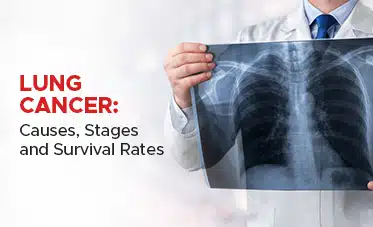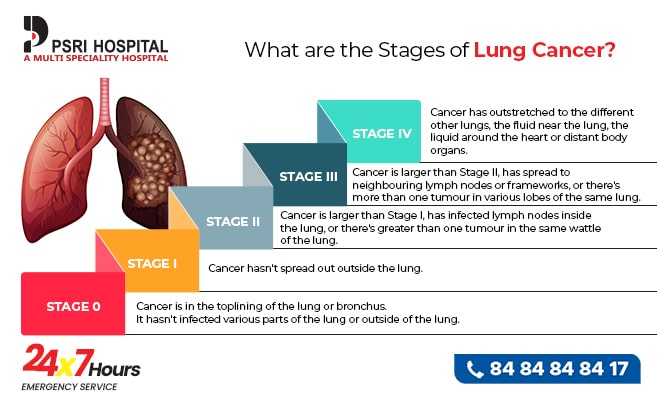Lung Cancer: Causes, Stages and Survival Rates

Lung cancer is a significant and also typically deadly disease affecting millions worldwide. With signs and symptoms that can typically go undetected in its onset, lung cancer poses a significant hazard to many people.
Nonetheless, there is hope for those who have been detected with lung cancer. With innovations in therapy choices and also a greater understanding of lung cancer causes as well as stages, patients now have a better possibility of making it through than ever.
In this blog, we will certainly discover lung cancer stages as well as reasons and also the latest treatments available. In addition, we will delve into the crucial subject of lung cancer survival rates, giving you the details you require to better recognize this condition and take action to safeguard yourself and your loved ones. So let’s dive into this.
What is Lung Cancer?
Lung cancer cells occur when cells in the lungs expand and divide uncontrollably, creating a mass or tumor. Lung cancer can establish in any part of the lungs and also can spread to other parts of the body, making it a potentially life-threatening condition.
There are two main types of lung cancer: small-cell lung cancer and non-small-cell lung cancer cells. Small-cell lung cancer cells are less usual as well as often tend to expand and also spread quickly. Non-small cell lung cancer cells, on the other hand, are the most typical type and usually expand extra gradually.
What are the Causes of Lung Cancer?
Several aspects can boost a person’s danger of developing lung cancer cells. One of the most common lung cancer causes is smoking tobacco, including pipes, cigars, and cigarettes. Tobacco smoke consists of numerous dangerous chemicals that can harm the cells in the lungs and also bring about cancer cells.
Other variables that can boost the danger of lung cancer include direct exposure to secondhand smoke, exposure to radon gas, a normally happening radioactive gas that can be found in houses as well as structures, exposure to asbestos as well as various other hazardous products, as well as a family history of lung cancer cells.
Additionally, some hereditary mutations have been linked to the advancement of lung cancer cells, especially in non-smokers. People with a background of certain lung illnesses, such as chronic obstructive lung illness (COPD) and lung fibrosis, may likewise be at boosted danger of developing lung cancer.
What are the Stages of Lung Cancer?
Each lung cancer stages has several sizes and spread mixes that can fall into that category. For instance, the initial tumor in Stage III cancer cells could be less than in Stage II cancer, but other factors identified it at a more advanced phase. The basic staging for lung cancer is:

What Are The Symptoms of Lung Cancer?
The majority of the symptoms of lung cancer appear similar to various other, less major ailments. Many individuals don’t have symptoms until the condition progresses, but some individuals have signs in the early stages. For those that do experience signs and symptoms, it may just be one or a few of these:
- A cough that gets worse over time.
- Trouble breathing or shortness of breath (dyspnea).
- Chest pain or discomfort.
- Wheezing.
- Coughing up blood (hemoptysis).
- Unexplained weight loss.
- Unexplained fatigue (tiredness).
- Shoulder pain.
- Hoarseness.
- Loss of appetite.
- Swelling in the face, arms, neck, or upper chest (superior vena cava syndrome).
- Small pupil and sagging eyelid in one eye with little or no sweating on that side of your face (Horner’s syndrome).
If you get any of these symptoms, seek advice from the best hospital in New Delhi. At PSRI Hospital, we have a specialist team of doctors that will give the best possible solution to any of your lung problems.
Lung Cancer Survival Rates
Nobody, not even your doctors, can predict with certainty how long you will survive after receiving your diagnosis. But a significant indicator is how quickly your cancer was discovered. Sadly, it spreads quickly, but you might not immediately experience any symptoms of lung cancer.
Due to this, 40% of lung cancer cases aren’t found until the fourth and most severe stage. Additionally, compared to older people, younger people typically survive longer after diagnosis.
- The five-year survival rate for lung cancer cells is 18.6%, which is less than lots of various other typical cancer cell areas like the colon (64.5%), bust (89.6%), and also prostate (98.2 percent).
- For situations of lung cancer cells located while the health problem is still localized, the five-year survival price is 56%. Just 16% of lung cancer cell people get a very early medical diagnosis and treatment.
- Over half of the people living with lung cancer pass away within a year of diagnosis.
For successful lung cancer treatment, you should always find the best hospital in Delhi NCR who have expertise in dealing with any kind of lung cancer condition.
Conclusion
Finally, lung cancer cells are a complicated illness impacting millions worldwide. While cigarette smoking is the leading lung cancer causes, several other risk aspects can enhance an individual’s opportunities of developing this disease. Early discovery is essential in enhancing the opportunities for survival, and also it is essential to go through routine tests if you go in danger.
So if you are suffering from lung cancer or know someone who is, then feel free to consult our highly specialized doctors at PSRI Hospital, the best multispeciality hospital in Delhi. We have the best team of pulmonologists in Delhi NCR, who have years of experience in giving the best possible treatment for all your lung problems.
FAQs
Q1: What is the stage 4 lung cancer survival rate?
Ans: The phase 4 lung cancer survival rate is usually less than earlier, as cancer has actually infected other body components. The survival rate can differ depending on elements such as the person’s age, general wellness, and the type of therapy received. According to the American Cancer Society, the total 5-year survival rate for stage 4 non-small cell lung cancer cells is around 6%.
Q2: Is lung cancer curable?
Ans: In some cases, lung cancer can be treated if discovered as well as treated early. The possibilities of a cure reduce as cancer cells spread and advance to other body components.
Q3: How many stages in lung cancer?
Ans: There are normally four phases of lung cancer: phase 1, stage 2, phase 3, and stage 4. Stage 1 and 2 lung cancer cells are considered early-stage, while phases 3 and 4 are advanced-stage cancer cells. The lung cancer cells stage is identified by the size and location of the tumor, along with whether the cancer cells have infected other parts of the body.
Q4: What are some usual symptoms of lung cancer?
Ans: Common symptoms of lung cancer include coughing (frequently with blood), shortness of breath, upper body discomfort, hoarseness, inexplicable weight reduction, fatigue, and recurrent lung infections. Nonetheless, many people with lung cancer cells do not experience symptoms at the beginning of the disease.
Q5: Can non-smokers get lung cancer?
Ans: Yes, non-smokers can get lung cancer, although smoking cigarettes is one of the most common reasons. Various other threat elements for lung cancer include exposure to secondhand smoke, exposure to radon gas, direct exposure to asbestos and various other harmful materials, and a family history of lung cancer cells.

 Book An Appointment
Book An Appointment Virtual Consultation
Virtual Consultation




